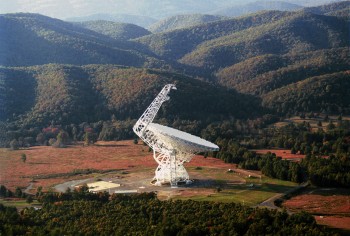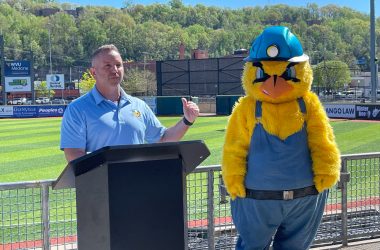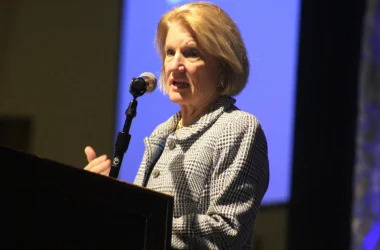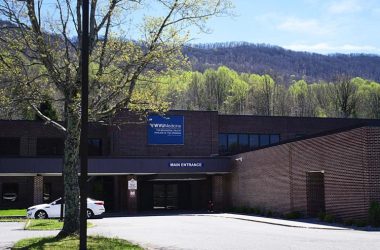
While the staff at the Green Bank Observatory, home to the heavily used Robert C. Byrd Green Bank Telescope, the world’s largest fully steerable radio telescope, recently celebrated moving forward as an independent research center, they now have a new challenge — the possibility of the National Science Foundation opting to mothball or “deconstruct” the facility.
CHARLESTON, W.Va. — A new challenge looms on the horizon for staffers at Pocahontas County’s Green Bank Observatory.
The staff recently celebrated the observatory moving forward as an independent research center, despite being dropped from the National Radio Astronomy system and having funding from its parent organization, the National Science Foundation, dramatically chopped. Now they face the possibility of the National Science Foundation opting to mothball or “deconstruct” the facility.
On Oct. 19, the National Science Foundation, which owns the observatory’s land and paid for its facilities, filed notice in the Federal Register that it was initiating the public scoping process for a Draft Environmental Impact Statement focusing on five proposed alternatives for the observatory’s future. They include:
Continued operation of the observatory for science-focused operations, relying on NSF funding, as was done in the past.
Continued operation of the observatory through collaboration with and funding from private and public partners for science- and education-focused operations, with reduced NSF funding, which is the current situation at Green Bank.
Collaboration with interested parties for operating the site as a technology and education park.
Suspending operations at the observatory and mothballing all facilities pending a possible resumption of activities at a later date.
“Deconstruction” of the facility, followed by “site restoration.”
Formed in 1956 as the first, and at that time, only, site of the National Radio Astronomy Observatory system, the Green Bank Observatory occupies 2,200 acres of forest and farmland bought by the U.S. Army Corps of Engineers in the heart of what would become the 13,000-square-mile National Radio Quiet Zone, in which all radio transmissions are limited to enhance the detection of faint signals from celestial sources.
In addition to the observatory’s heavily used Robert C. Byrd Green Bank Telescope, the world’s largest fully steerable radio telescope, the observatory is home to three smaller and older radio telescopes and the Green Bank Solar Radio Burst Spectrometer.
While the Green Bank Telescope has proven itself to be a premier instrument for use in studying black holes, pulsars, star formation, gravitational waves and connections between organic chemicals in space with the formation of life on Earth, a Foundation astronomical sciences portfolio review committee in 2012 recommended dropping financial support for the Green Bank Telescope in favor of newer instruments believed to be better suited for meeting the foundation’s science goals.
The Foundation has yet to accept the portfolio review committee’s recommendation to divest itself of the Green Bank Observatory, but it has cut funding to 60 percent of its former level during the current fiscal year and has announced plans to slash funding another 30 percent during the 2017-2018 fiscal year.
O’Neil said the Environmental Impact Statement process takes into account “vastly more than just the environment. It’s looking also at societal, economic, community and scientific impacts as well as the normal environmental factors.” By initiating the EIS process, the NSF is indicating that it “still has not decided what path to go down for the facility,” she said.
The five preliminary alternatives will be discussed, and public comments taken, at a pair of public scoping meetings to be held from 3 to 5 p.m. and from 6 to 8 p.m. on Nov. 9, in the Green Bank Observatory Science Center. Public comments can also be sent by email to [email protected] or to Elizabeth Pentecost, re: Green Bank Observatory, National Science Foundation, 4201 Wilson Boulevard, Suite 1045, Arlington, VA 22230. Deadline for written comments is Nov. 19.
“This is the only public comment period that will exist until a draft report and draft recommendation for the future is written,” said O’Neil. “It’s a pretty big deal for us and we need to get through it.”
While closure of the observatory “is an option being considered,” O’Neil said, “I would like to believe the NSF understands the value of our facility and what we do. But this process is the community’s chance to ensure that all aspects of the Observatory’s value are known to the NSF, and are carefully considered before any decision is made.
“I believe we will come out of it OK, but only if everyone who finds value in the Observatory communicates that value to the NSF through the scoping process.”
Among members of the public already responding on Green Bank’s behalf is Deana White of Barboursville, who has helped form a grassroots support group called Get Organized for the Green Bank Observatory and launched a Facebook page, “Go Green Bank Observatory,” to support the Pocahontas County research center through the scoping/EIS process.
The Facebook page includes links to the NSF’s Environmental Impact Statement process for Green Bank, contact information for state legislators and members of West Virginia’s Congressional delegation, fact sheets on the Green Bank Observatory’s operations and discoveries, and guidance documents for preparing public comments for submission.
“I can’t tell you how life-changing this place has been for our family,” said White, who first became acquainted with the observatory after making a wrong turn after departing Snowshoe Mountain Resort with her husband 20 years ago and becoming intrigued with the facility.
Since then, her daughter, Ellie, and son, Josh, have taken part in a number of astronomy and STEM training programs at the observatory, including the Radio Astronomer for a Day program and served as volunteers during the observatory’s Family Science Day events.
Ellie White, who makes hand-sewn dolls representing people in European countries, began producing dolls representing such scientists as Marie Curie, Albert Einstein, and radio astronomy pioneer Grote Reber, and donating them to the observatory for sale in the Science Center’s gift shop for fundraising purposes.
“The observatory has given her a tremendous opportunity to learn about radio astronomy, including how to operate the 40-foot telescope, how to troubleshoot and how think critically,” said Deana. “We want to do anything we can to help keep it operating.”
Reach Rick Steelhammer at [email protected], 304-348-5169 or follow @rsteelhammer on Twitter.





